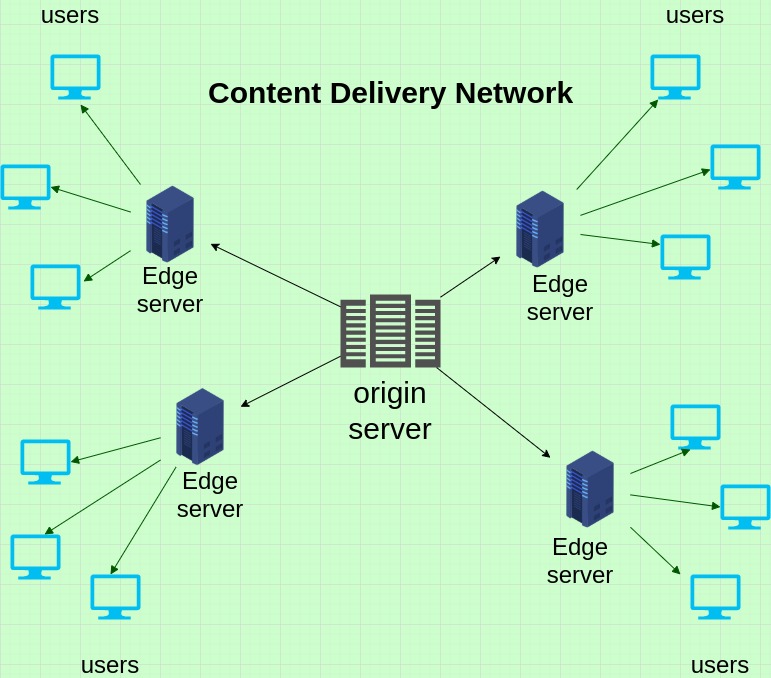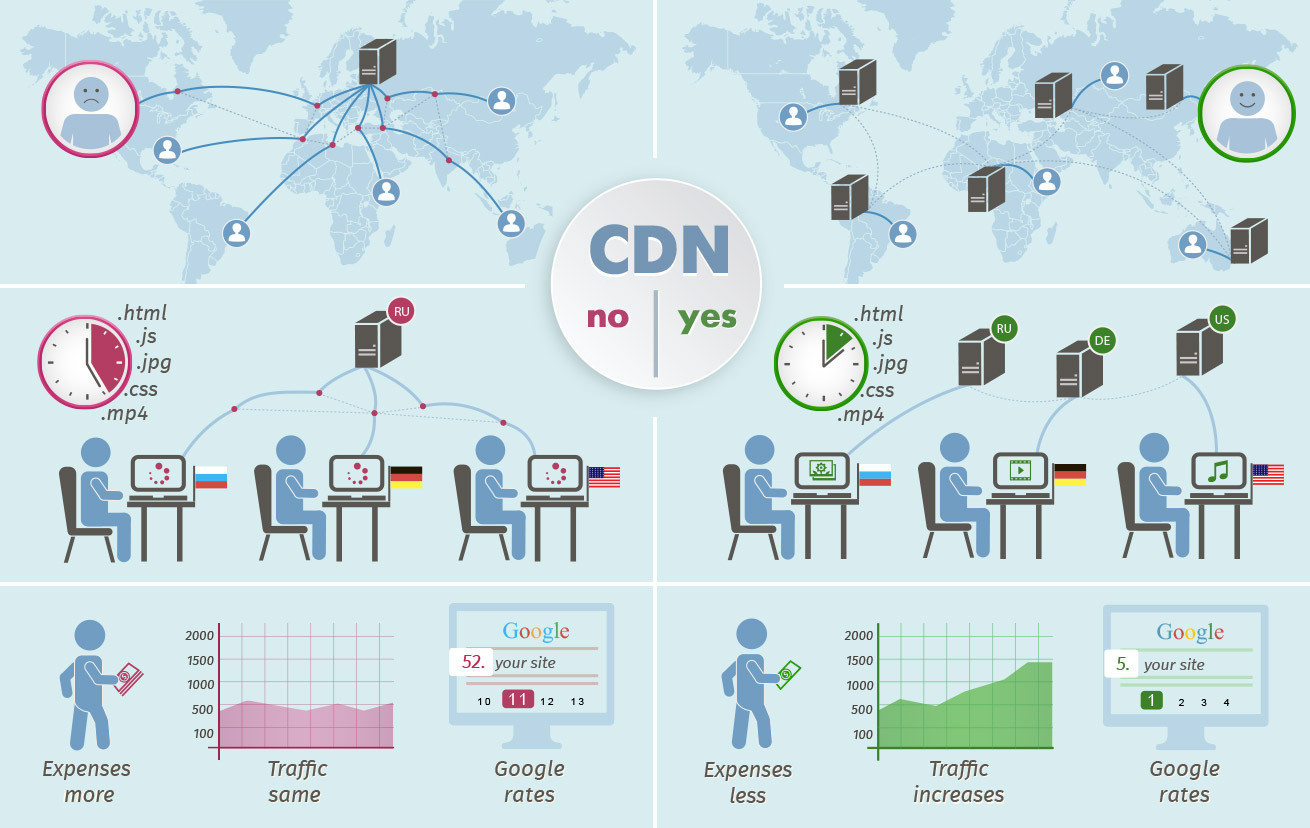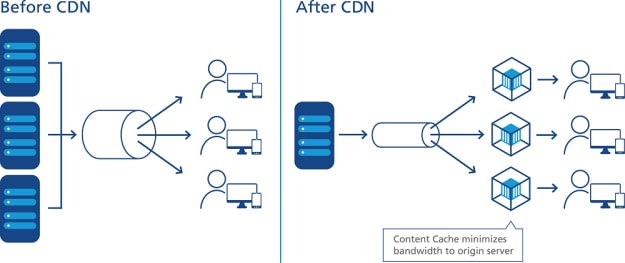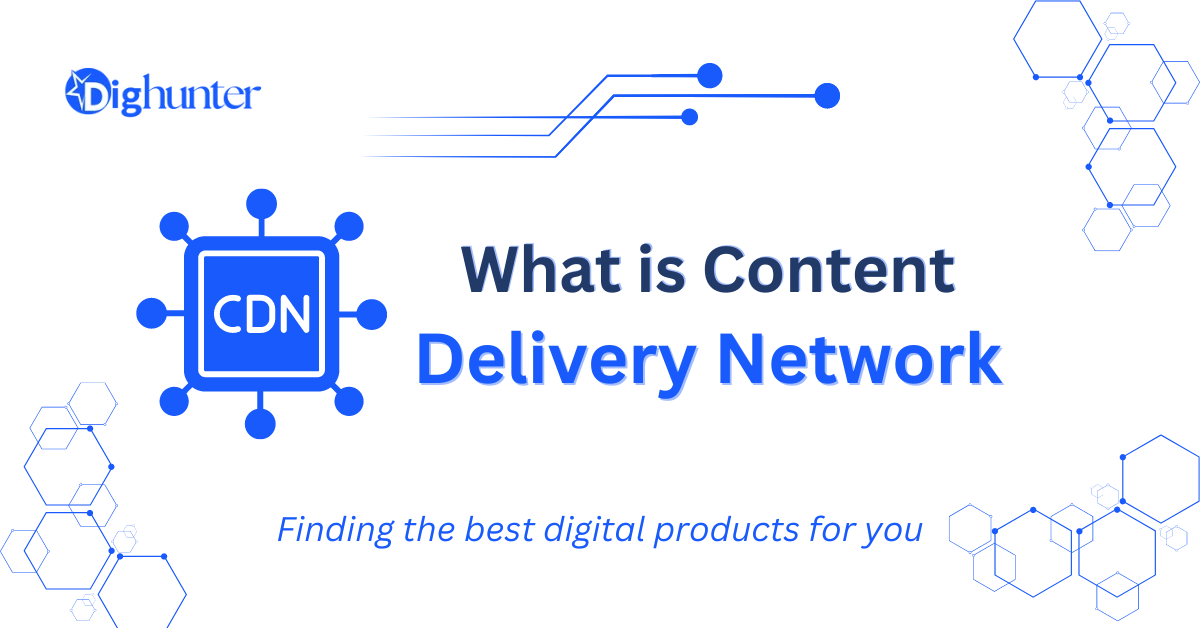A Content Delivery Network (CDN) is a system of distributed servers. It delivers web content based on user location.
A CDN accelerates website performance by distributing content across multiple servers globally. This network ensures faster load times and reduces latency by serving data from the nearest server to the user. CDNs enhance website security by mitigating DDoS attacks and providing SSL encryption.
They also improve user experience, especially for streaming services and large-scale websites. Businesses benefit from reduced bandwidth costs and increased site reliability. CDNs support various content types, including videos, images, and HTML pages. Using a CDN is essential for websites aiming for high availability and performance. This technology plays a crucial role in modern web infrastructure.

Credit: cloudkul.com
➡️What is a CDN?
In today’s fast-paced digital world, speed is everything. Content Delivery Networks (CDNs) play a crucial role in delivering content quickly and efficiently. But what exactly is a CDN?
Basics of CDN
A Content Delivery Network (CDN) is a system of distributed servers that deliver web content to users based on their geographic location. The primary goal of a CDN is to reduce latency and improve website performance.
Here are some key points about CDNs:
- Latency Reduction: CDNs minimize the distance data travels, which reduces load times.
- Scalability: CDNs handle high traffic volumes without slowing down.
- Reliability: CDNs provide redundancy, ensuring content remains available even if one server fails.
For example, imagine a user in New York accessing a website hosted in London. Without a CDN, the request travels across the Atlantic. With a CDN, a local server in New York handles the request, speeding up the process.
| Feature | Benefit |
|---|---|
| Geographic Distribution | Faster content delivery |
| Load Balancing | Efficient traffic management |
| Caching | Reduced server load |
Key Components
CDNs consist of several key components that work together to deliver content quickly and reliably:
- Edge Servers: These are strategically placed servers that cache content close to end-users. Edge servers reduce latency and improve load times.
- Origin Server: This is the main server where the original content is stored. The origin server sends content to edge servers when needed.
- PoPs (Points of Presence): These are data centers housing edge servers. PoPs are located in various geographic locations to ensure content is always close to users.
- CDN Software: This manages the distribution of content, load balancing, and caching. The software ensures that requests are directed to the nearest edge server.
Consider the following example: A video streaming site uses a CDN. The video is stored on the origin server. When a user requests the video, the CDN software directs the request to the nearest edge server. The edge server delivers the video quickly, ensuring a smooth viewing experience.
| Component | Function |
|---|---|
| Edge Servers | Cache and deliver content |
| Origin Server | Store original content |
| PoPs | House edge servers |
| CDN Software | Manage content delivery |
Understanding these components helps in grasping how CDNs enhance web performance.
Benefits of Using a CDN
A Content Delivery Network (CDN) is a network of servers distributed globally to deliver web content efficiently. Using a CDN offers numerous benefits for website owners and users. Here, we explore the key advantages of utilizing a CDN.
Improved Load Times
One of the most significant benefits of using a CDN is the improvement in load times. Faster load times enhance user experience and boost search engine rankings.
CDNs achieve this by:
- Reducing latency: CDNs store copies of your content on multiple servers worldwide. When a user requests content, the CDN delivers it from the nearest server, minimizing delays.
- Optimizing delivery: CDNs use techniques like file compression and image optimization to speed up content delivery.
A slow website can frustrate users and lead to higher bounce rates. With a CDN, you can ensure your website loads quickly, keeping visitors engaged. Here’s a comparison of load times with and without a CDN:
| Region | Without CDN | With CDN |
|---|---|---|
| North America | 3 seconds | 1.5 seconds |
| Europe | 4 seconds | 2 seconds |
| Asia | 5 seconds | 2.5 seconds |
Increased Security
Another major advantage of using a CDN is enhanced security. CDNs provide multiple layers of protection against various online threats.
Key security features include:
- DDoS protection: CDNs can absorb and mitigate Distributed Denial of Service (DDoS) attacks, preventing your website from going offline.
- SSL/TLS encryption: CDNs offer secure connections through SSL/TLS encryption, protecting sensitive data during transmission.
- Web Application Firewall (WAF): CDNs often include WAFs that filter out malicious traffic and block attacks such as SQL injection and cross-site scripting (XSS).
With these security measures, your website is better protected against cyber threats. This not only safeguards your data but also builds trust with your users. Here is a quick overview of CDN security features:
| Security Feature | Description |
|---|---|
| DDoS Protection | Absorbs and mitigates large-scale attacks |
| SSL/TLS Encryption | Secures data in transit |
| WAF | Filters malicious traffic |
➡️How CDNs Work
A Content Delivery Network (CDN) is a system of distributed servers that deliver web content and pages to users based on their geographic location. The primary goal of a CDN is to improve website load times and reduce latency. Let’s dive into how CDNs work and understand the essential components involved.
Data Caching
Data caching is a fundamental aspect of how CDNs operate. CDNs store copies of web content in multiple locations around the world. These copies are cached, meaning they are saved temporarily for quicker access. When a user requests content from a website, the CDN delivers the cached content from the server nearest to the user. This speeds up the loading process significantly.
The following are key points about data caching:
- Reduces Latency: By serving content from a nearby server, the time it takes for data to travel is minimized.
- Improves Load Times: Cached data is delivered faster than retrieving it from the origin server every time.
- Enhances User Experience: Faster load times lead to a better user experience and higher user satisfaction.
Types of Data Cached include:
| Type of Data | Description |
|---|---|
| Static Content | Images, CSS files, JavaScript files |
| Dynamic Content | HTML pages, API responses |
| Video Content | Streaming videos, live broadcasts |
Edge Servers
Edge servers are the backbone of CDNs. These servers are strategically placed around the globe to be as close to end-users as possible. Edge servers store cached copies of website content and handle user requests quickly and efficiently. This proximity reduces the distance data has to travel, thus enhancing performance.
Here are some important points about edge servers:
- Geographical Distribution: Edge servers are located in multiple cities and countries, ensuring global coverage.
- Load Balancing: They distribute traffic evenly, preventing any single server from being overwhelmed.
- Redundancy: Multiple edge servers in various locations ensure availability even if one server fails.
Functions of Edge Servers include:
- Content Delivery: Serve cached content to users quickly.
- Request Routing: Direct user requests to the nearest or most efficient server.
- Security Filtering: Protect against malicious attacks and unauthorized access.
Edge servers play a crucial role in CDN performance. They ensure that users receive content swiftly, no matter where they are located. This makes web browsing faster and more reliable.
➡️Types of CDNs
A Content Delivery Network (CDN) helps deliver web content faster by distributing it across multiple servers. CDNs improve website performance and user experience. Understanding the Types of CDNs is crucial for choosing the right solution for your needs. The two main types are Public CDNs and Private CDNs.
Public Cdns
Public CDNs are shared among multiple users and websites. They are managed by third-party providers. These CDNs offer many benefits:
- Cost-effective: You share the infrastructure with others, reducing costs.
- Scalability: Public CDNs can handle large amounts of traffic without issues.
- Ease of use: Setting up a public CDN is usually straightforward.
- Global reach: They have many Points of Presence (PoPs) worldwide.
Some popular public CDN providers include:
| Provider | Features |
|---|---|
| Cloudflare | Free plan, global coverage, DDoS protection |
| Amazon CloudFront | Pay-as-you-go, integrated with AWS services |
| Google Cloud CDN | Low latency, secure, integrated with Google Cloud |
Public CDNs are ideal for small to medium-sized websites. They provide reliable performance and security without high costs.
Private Cdns
Private CDNs are dedicated to a single user or organization. They offer more control and customization. Key benefits include:
- Enhanced security: Only authorized users can access the content.
- Customization: You can tailor the CDN to your specific needs.
- Performance optimization: Fine-tuned for your content and audience.
- Dedicated resources: No sharing with other users, ensuring consistent performance.
Private CDNs are suitable for:
- Large enterprises: Companies with significant traffic and specific security needs.
- Media companies: Businesses that deliver large amounts of video and audio content.
- E-commerce platforms: Online stores require high security and performance.
Some examples of private CDN solutions include:
- Akamai Private CDN
- Limelight Private CDN
- Fastly Private CDN
Private CDNs provide a robust, secure, and customizable solution for large businesses. They ensure high performance and offer specialized features tailored to specific needs.
➡️Choosing a CDN Provider
A Content Delivery Network (CDN) helps deliver your website content to users faster and more reliably. Choosing the right CDN provider is crucial for ensuring optimal performance and user experience. There are many factors to consider, including key features and cost. This guide will help you make an informed decision.
Key Features To Look For
When selecting a CDN provider, it’s essential to assess the features they offer. Here are some critical features to consider:
- Global Coverage: Ensure the CDN provider has a vast network of servers worldwide. This ensures fast content delivery to users, regardless of their location.
- Security: Look for features like DDoS protection, SSL support, and web application firewall (WAF). These features safeguard your website from cyber threats.
- Performance: Check for real-time analytics, load balancing, and caching strategies. These features enhance the speed and reliability of your website.
- Scalability: A good CDN should easily handle traffic spikes without compromising performance. This is crucial for growing websites.
- Customer Support: 24/7 support is essential. Look for providers offering multiple support channels, such as chat, phone, and email.
Cost Considerations
The cost of a CDN can vary widely based on your needs and the provider’s pricing model. Here are some cost factors to consider:
| Cost Factor | Description |
|---|---|
| Bandwidth | Some CDNs charge based on the amount of data transferred. This is ideal for low-traffic websites. |
| Requests | Others charge per request made to the CDN. High-traffic websites might find this model more cost-effective. |
| Geographic Distribution | Costs can vary based on the regions your users are in. Delivering content in less common regions might be more expensive. |
| Additional Services | Features like advanced security, custom SSL, and real-time analytics might come at an extra cost. |
It’s crucial to analyze your website’s needs and budget. Compare multiple providers to find the best fit for your requirements.
➡️CDN and SEO
Content Delivery Networks (CDNs) play a crucial role in ensuring the fast and efficient delivery of web content. A CDN helps distribute website assets across multiple servers worldwide, reducing load times and improving user experience. The relationship between a CDN and SEO is significant, as both aim to enhance website performance and visibility. Understanding how a CDN impacts SEO can help you optimize your site for better rankings and faster loading times.
Impact on Rankings
Google and other search engines prioritize user experience and site speed. Using a CDN can positively impact your site’s search engine rankings by enhancing these factors. Here’s how:
- Reduced Latency: A CDN stores copies of your website content on multiple servers around the globe. This reduces the distance between the user and the server, leading to faster load times.
- Higher Availability: CDNs distribute traffic across multiple servers, reducing the risk of server overload. This ensures your site remains accessible even during high-traffic periods.
- Improved Mobile Experience: Faster load times on mobile devices can lead to better mobile search rankings. A CDN can significantly enhance the mobile user experience.
Search engines consider these factors when ranking websites. By improving site speed and reliability, a CDN can help boost your SEO performance. Below is a table summarizing the impact of CDN on SEO rankings:
| SEO Factor | Impact of CDN |
|---|---|
| Site Speed | Improves due to reduced latency |
| Uptime | Higher availability and reliability |
| Mobile Experience | Enhanced due to faster load times |
Page Speed Factors
Page speed is a critical factor in SEO and user experience. CDNs play a pivotal role in optimizing page speed. Here are some key ways:
- Asset Caching: CDNs cache static assets like images, CSS, and JavaScript files. This reduces the load on the origin server and speeds up content delivery.
- Minimized Round-Trip Time (RTT): By hosting content closer to the user, CDNs reduce the time it takes for data to travel between the server and the user.
- Load Balancing: CDNs use load-balancing techniques to distribute traffic evenly across multiple servers. This prevents server overload and ensures consistent performance.
Faster page load times lead to lower bounce rates and higher user engagement. Google’s algorithms favor sites that load quickly, offering them higher rankings in search results. Below is a list summarizing the benefits of CDN on page speed:
- Quicker Load Times: Users access content faster due to reduced latency.
- Improved Reliability: Multiple servers ensure continuous availability.
- Enhanced User Experience: Faster pages keep users engaged longer.
Optimizing page speed with a CDN can significantly improve both user satisfaction and search engine rankings.
➡️Common CDN Misconceptions
Content Delivery Networks (CDNs) have become essential for improving website performance and user experience. Despite their benefits, many misconceptions surround CDNs, preventing businesses from fully leveraging their potential. Let’s debunk some common CDN misconceptions.
CDNs Are Only For Large Websites
Many believe that CDNs are only useful for large websites. This is a common misconception. CDNs provide benefits to websites of all sizes.
Here are some key reasons why small and medium websites should also use CDNs:
- Faster Load Times: CDNs reduce latency by serving content from the nearest server to the user.
- Better User Experience: Faster load times lead to a better user experience, which can increase engagement and reduce bounce rates.
- Improved SEO: Search engines prefer faster websites. Using a CDN can help improve your website’s ranking.
- Scalability: CDNs can handle traffic spikes efficiently, making your website more reliable.
Even small websites can experience traffic surges. A CDN ensures that your website remains accessible during these periods.
Consider a local bakery’s website that gets a sudden surge in traffic due to a viral social media post. Without a CDN, the website might crash, losing potential customers. With a CDN, the website remains stable and responsive.
In short, CDNs are not just for large websites. They offer significant advantages to websites of any size.
Complexity Issues
Another common misconception is that CDNs are too complex to implement. Many believe they require extensive technical knowledge.
Modern CDNs are designed to be user-friendly. Here are some points to consider:
- Easy Setup: Many CDN providers offer simple integration processes. Most can be set up within minutes.
- User-Friendly Dashboards: Providers offer intuitive dashboards for managing settings and monitoring performance.
- Comprehensive Support: CDNs come with extensive documentation and customer support. This helps users navigate any issues.
Here’s a comparison table to illustrate how easy it is to set up a CDN:
| Step | Description |
|---|---|
| 1 | Sign up with a CDN provider |
| 2 | Configure your domain settings |
| 3 | Integrate with your website platform |
| 4 | Activate and monitor performance |
As you can see, setting up a CDN is straightforward. You don’t need to be a technical expert.
Many providers offer plugins for popular content management systems like WordPress. These plugins further simplify the integration process.
In conclusion, the belief that CDNs are complex is a myth. Modern CDNs are designed for ease of use, making them accessible to everyone.

Credit: cyberhoot.com
➡️Future of CDNs
The future of Content Delivery Networks (CDNs) promises significant advancements. As the internet evolves, CDNs must adapt. Emerging technologies and changing trends will shape how CDNs operate. Understanding these changes helps businesses stay ahead.
Emerging Technologies
New technologies will transform CDNs. Edge computing is one such innovation. It brings data processing closer to users. This reduces latency and speeds up content delivery.
5G networks will also impact CDNs. With faster speeds and lower latency, 5G will enhance CDN performance. Users will enjoy quicker access to content.
Artificial Intelligence (AI) and Machine Learning (ML) are revolutionizing CDNs. AI can predict traffic patterns. ML can optimize content delivery routes. This ensures efficient and smooth operation.
Blockchain technology brings security to CDNs. It can prevent data tampering. This ensures content integrity and trustworthiness.
Here is a summary of emerging technologies:
| Technology | Impact on CDNs |
|---|---|
| Edge Computing | Reduces latency, speeds up delivery |
| 5G Networks | Enhances performance, quicker access |
| AI and ML | Predicts traffic, optimizes routes |
| Blockchain | Ensures security, prevents tampering |
Trends To Watch
Several trends are shaping the future of CDNs. Edge computing continues to grow. More businesses are adopting this technology. It offers faster and more reliable content delivery.
Increased use of video content is another trend. Videos demand high bandwidth. CDNs must adapt to this growing need. Efficient video delivery is crucial.
Internet of Things (IoT) devices are on the rise. These devices generate massive amounts of data. CDNs will need to handle this data efficiently.
Cybersecurity is becoming a top priority. As cyber threats increase, CDNs must offer robust security measures. Protecting user data is essential.
Here are the key trends to watch:
- Growth in edge computing
- Increased video content usage
- Rise of IoT devices
- Enhanced cybersecurity measures
➡️In a Nutshell
Content Delivery Networks (CDNs) are essential for modern websites. They ensure fast content delivery, improved user experience, and enhanced website security. In this final thought, let’s summarize the key points about CDNs and their benefits.
What is a Content Delivery Network?
A Content Delivery Network (CDN) is a system of distributed servers. These servers deliver web content to users based on their geographic location. CDNs improve website load times and reduce latency.
Key Benefits of Using a CDN
- Faster Content Delivery: CDNs store cached content in multiple locations.
- Enhanced User Experience: Users experience quicker load times.
- Improved Security: CDNs provide protection against DDoS attacks.
- Scalability: CDNs handle high traffic efficiently.
How Does A Cdn Work?
CDNs work by distributing content across multiple servers. These servers are strategically placed around the globe. When a user requests content, the CDN delivers it from the closest server. This process reduces latency and speeds up content delivery.
Cdn Vs Traditional Hosting
| Aspect | CDN | Traditional Hosting |
|---|---|---|
| Speed | Faster due to distributed servers | Slower, single server location |
| Security | Better with DDoS protection | Basic security measures |
| Scalability | Handles high traffic well | May struggle with high traffic |
Choosing the Right CDN
- Identify Your Needs: Consider speed, security, and scalability.
- Research Providers: Compare features and pricing.
- Test Performance: Use free trials to evaluate service quality.
Final Takeaway
Using a CDN is crucial for modern websites. They offer faster content delivery, better security, and improved user experience. Choose a CDN that fits your needs to enhance your website’s performance.

Credit: www.ntt.com
➡️Frequently Asked Questions
- What is a Content Delivery Network?
Ans: A Content Delivery Network (CDN) is a system of distributed servers. It delivers web content to users based on their geographic location. CDNs improve website load times and performance.
- How Does A Cdn Work?
Ans: A CDN works by caching content on multiple servers. These servers are strategically located worldwide. When a user requests content, the nearest server delivers it, reducing latency.
- Why Use A Cdn For Your Website?
Using a CDN improves website speed and reliability. It helps in handling high traffic volumes efficiently. CDNs also offer security benefits like DDoS protection.
- Can A Cdn Improve Website Seo?
Ans: Yes, a CDN can improve website SEO. Faster load times enhance user experience, leading to lower bounce rates. Search engines favor fast-loading websites.
➡️Final Thought
A Content Delivery Network (CDN) enhances website performance and security. It ensures fast content delivery to global users. Embracing CDNs can significantly improve user experience and boost SEO rankings. Invest in a reliable CDN to stay competitive. Achieve better load times, reduced server strain, and increased site resilience with a CDN.




